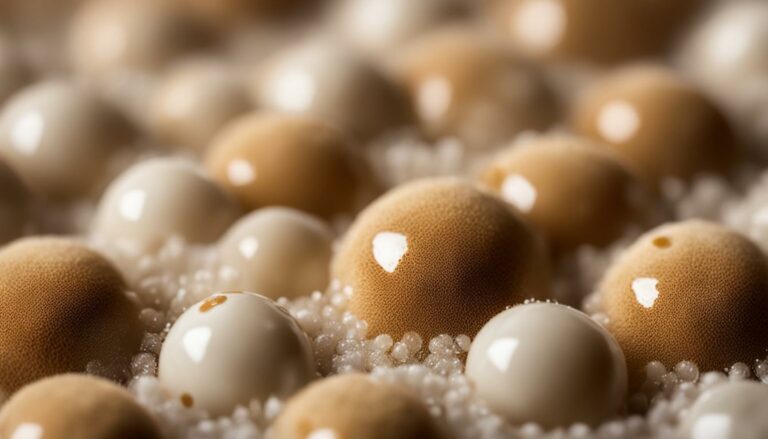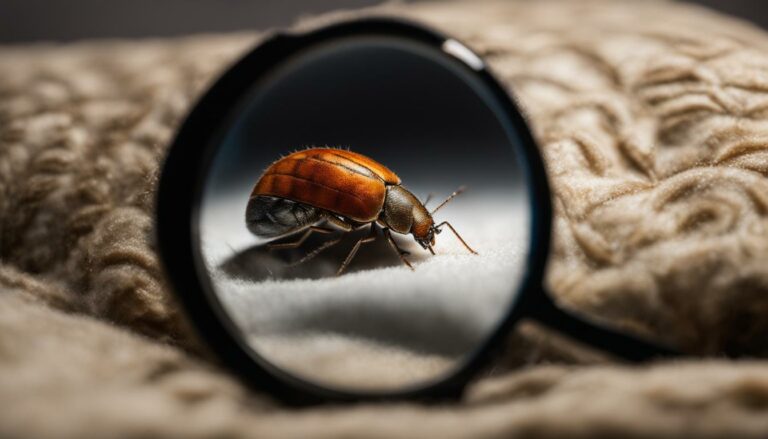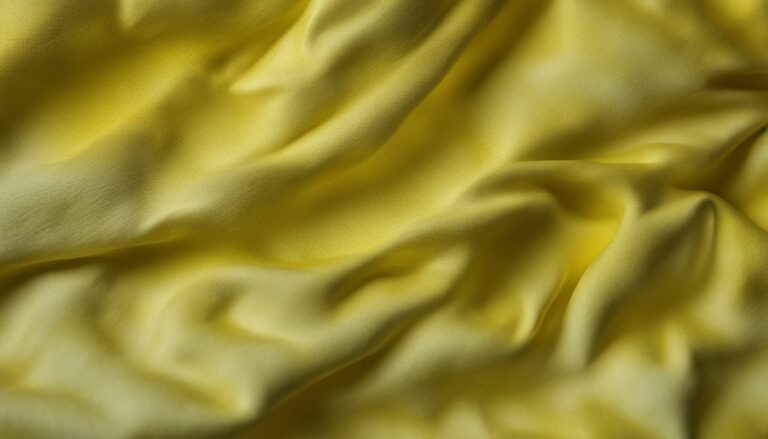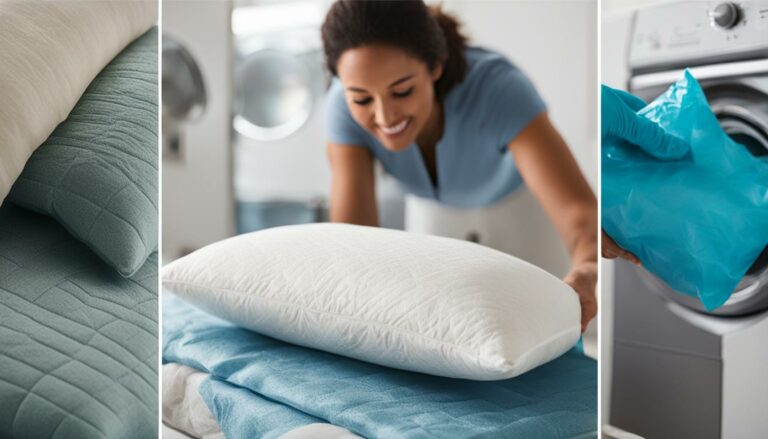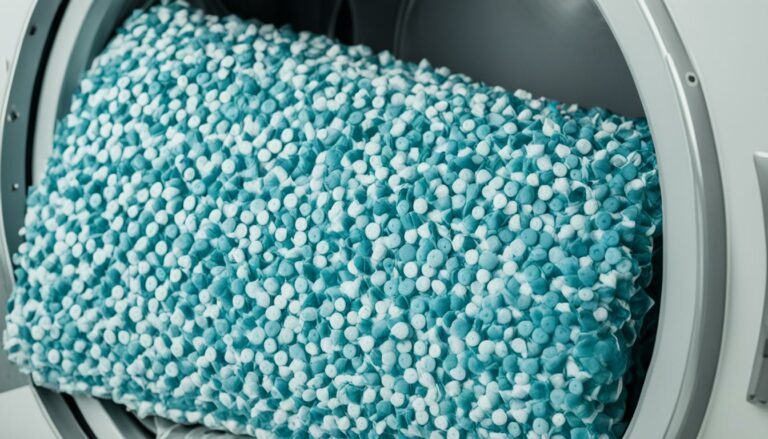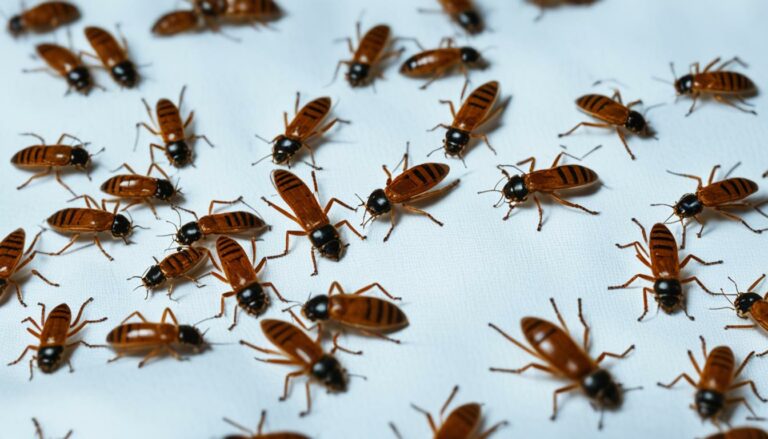Brighten Bedding: How to Whiten Pillowcases
Eric Christie stands as a luminary in the bedding industry, with a career spanning nearly four decades since the early 1980s. His journey through the world of bedding has seen him wear many hats – a manufacturer, designer, and retailer, showcasing his versatility and expertise in Read more...
pillowsandbedsheets.com and its partners may earn a commission if you purchase a product through one of our links
Pillowcases are an essential part of our bedding, but over time, they can become yellowed and lose their brightness due to sweat, body oils, and exposure to lotions and cosmetics. If you’re looking to restore the crisp, white appearance to your pillowcases, we have you covered. In this comprehensive guide, we’ll explore various effective methods for whitening your pillowcases, including natural remedies, DIY techniques, and professional tips.
Key Takeaways:
- There are several natural methods for whitening pillowcases, such as using lemon juice, vinegar, baking soda, and borax.
- Although bleach can be effective for whitening, it should be used with caution and as a last resort.
- Other whitening agents like liquid bluing and hydrogen peroxide can also help brighten pillowcases.
- Follow specific tips, such as pre-soaking, proper washing techniques, and air-drying, to maintain the whiteness of your pillowcases.
- If you’re dealing with yellow stains, there are soaking methods and preventive measures you can take to remove and avoid them.
Natural Methods for Whiter Pillowcases
If you prefer to use natural methods to whiten your pillowcases, there are a few options to consider. These DIY techniques can be effective in brightening your pillowcases and giving them a fresh, clean appearance.
Lemon juice is a natural bleaching agent that can help whiten your pillowcases. You can either add lemon juice to your washing machine along with your regular detergent or create a soaking solution by diluting lemon juice in water and letting your pillowcases soak for a few hours. The natural acids in lemon juice can help break down stains and restore the bright white color to your pillowcases.
Vinegar is another common household ingredient that can aid in pillowcase whitening. Add a cup of white vinegar to your washing machine during the rinse cycle to help remove any residual soap or detergent that can cause yellowing. Alternatively, you can create a soaking solution by combining water and vinegar, then soaking your pillowcases in the mixture before washing them as usual.
Baking soda is a versatile ingredient that can be used for various cleaning purposes, including pillowcase whitening. Adding a half cup of baking soda to your regular laundry detergent can help remove stains and brighten your pillowcases. Its abrasive nature can safely lift dirt and grime from the fabric, leaving your pillowcases looking fresh and white.
Borax is another natural remedy that can be effective in whitening pillowcases. By adding half a cup of borax to your laundry load, you can enhance the cleaning power of your detergent and help remove stubborn stains from your pillowcases. Borax is known for its stain-fighting properties and can assist in bringing back the pristine whiteness to your bedding.
Remember to follow the instructions for these natural methods and test them on a small area of your pillowcases before using them on the entire fabric. This way, you can ensure that the ingredients won’t cause any damage or discoloration. With these simple DIY techniques, you can enjoy naturally whiter pillowcases without the use of harsh chemicals.
Benefits of Using Natural Methods
Choosing natural methods for pillowcase whitening offers several advantages. Firstly, these methods are often safer for the environment compared to harsh chemical bleach. Secondly, natural ingredients like lemon juice, vinegar, baking soda, and borax are readily available and affordable, making them convenient options for DIY pillowcase whitening. Lastly, natural methods are gentle on the fabric, helping to maintain the overall quality and lifespan of your pillowcases.
| Method | Description |
|---|---|
| Lemon Juice | Can be used in the washing machine or as a soaking solution to brighten yellowed pillowcases. |
| Vinegar | Add to the washing machine or use as a soaking solution to help whiten pillowcases. |
| Baking Soda | Add with your regular detergent to remove stains and brighten pillowcases. |
| Borax | Enhances the cleaning power of your detergent and helps remove stubborn stains. |
Using Bleach to Whiten Pillowcases
Although bleach is not the recommended solution for whitening pillowcases, it can still be used in certain situations. It is essential to be aware that bleach can react with protein stains and should not be used on silk sheets. If you choose to use bleach, follow these proper steps to ensure safe and effective whitening:
- Mix bleach with water: Dilute the bleach according to the instructions on the product label. This will help prevent damage to the fabric and reduce the risk of skin irritation.
- Pre-treat stains: Before adding the pillowcases to the bleach solution, pre-treat any stains using a stain remover or laundry detergent.
- Soak the pillowcases: Submerge the pillowcases in the bleach solution and allow them to soak for about 15 minutes. This will help the bleach penetrate the fabric and break down any discoloration.
- Wash as usual: After soaking, wash the pillowcases in the washing machine with a mild detergent to remove any bleach residue.
- Avoid excessive use: Limit the use of bleach to prevent wear and tear on the fabric. Excessive bleaching can weaken the fibers and cause them to yellow or become brittle over time.
Alternatively, if you prefer not to use bleach, there are other effective options available for whitening your pillowcases:
- Non-chlorine oxygen bleach: This type of bleach is gentler on fabrics and can be used as a suitable alternative to traditional bleach. It is particularly recommended for delicate fabrics like silk.
- Natural remedies: Lemon juice and vinegar can also be used to whiten pillowcases. Lemon juice, with its natural bleaching properties, can be applied directly to the fabric or added to the washing machine. Vinegar, when used during the rinse cycle, can help remove stains and brighten the pillowcases.
Remember to always check the care instructions on your pillowcases and test any whitening method on a small, inconspicuous area before applying it to the entire fabric. This will help ensure that the whitening technique is safe and does not cause any damage.
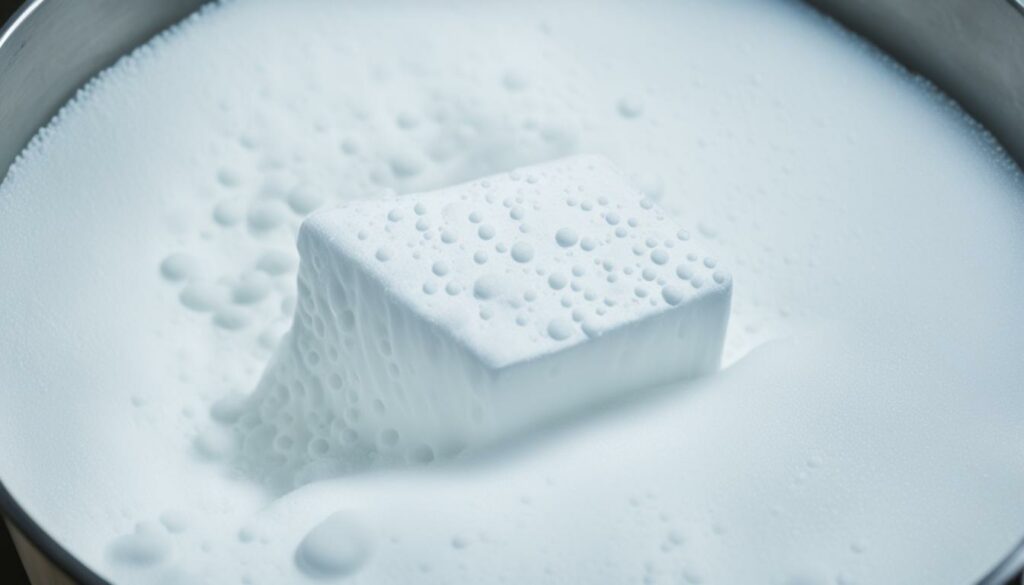
Benefits of Non-chlorine Oxygen Bleach
Non-chlorine oxygen bleach is a suitable option for whitening pillowcases without the harsh effects of traditional bleach. Here are some benefits:
“Non-chlorine oxygen bleach is gentle on fabrics, making it ideal for delicate pillowcases like silk. It can effectively remove stains and whiten without causing damage or weakening the fibers.”
| Benefits of Non-chlorine Oxygen Bleach |
|---|
| Gentle on fabrics |
| Effective stain removal |
| No damage to fibers |
| Safe for delicate pillowcases |
Other Whitening Agents for Pillowcases
In addition to lemon juice, vinegar, and bleach, there are other alternative whitening agents that can effectively brighten your pillowcases. These agents provide different approaches to tackle yellowing and restore the white brilliance of your bedding.
Liquid Bluing
If you’re looking to neutralize yellow undertones and achieve whiter pillowcases, consider using liquid bluing. When properly diluted and added to the washing machine, liquid bluing can help brighten your fabrics and give them a fresh appearance. Its unique formulation is specifically designed to counteract the yellowing of pillowcases, leaving them crisp and clean.
| Whitening Agent | Application Method | Effectiveness |
|---|---|---|
| Liquid Bluing | Add to the washing machine | Neutralizes yellow undertones and brightens pillowcases |
Note: Make sure to follow the instructions on the packaging for proper usage and dilution ratios when using liquid bluing.
Hydrogen Peroxide
Another effective alternative for whitening pillowcases is hydrogen peroxide. When combined with other cleaning agents, hydrogen peroxide can help remove stains and restore the whiteness of your pillowcases. It’s a versatile option that can be used in various cleaning methods, providing you with flexibility based on your specific needs.
When using hydrogen peroxide, it’s essential to follow the appropriate instructions and safety guidelines to achieve optimal results.
| Whitening Agent | Application Method | Effectiveness |
|---|---|---|
| Hydrogen Peroxide | Combine with other cleaning agents | Aids in stain removal and whitening |
Remember to exercise caution when using hydrogen peroxide and follow the instructions provided.
By utilizing these alternative whitening agents, you have additional options to revitalize your pillowcases and maintain their pristine appearance.
Next, we’ll explore essential tips and techniques that can help you achieve even whiter pillowcases and prevent yellowing in the future.
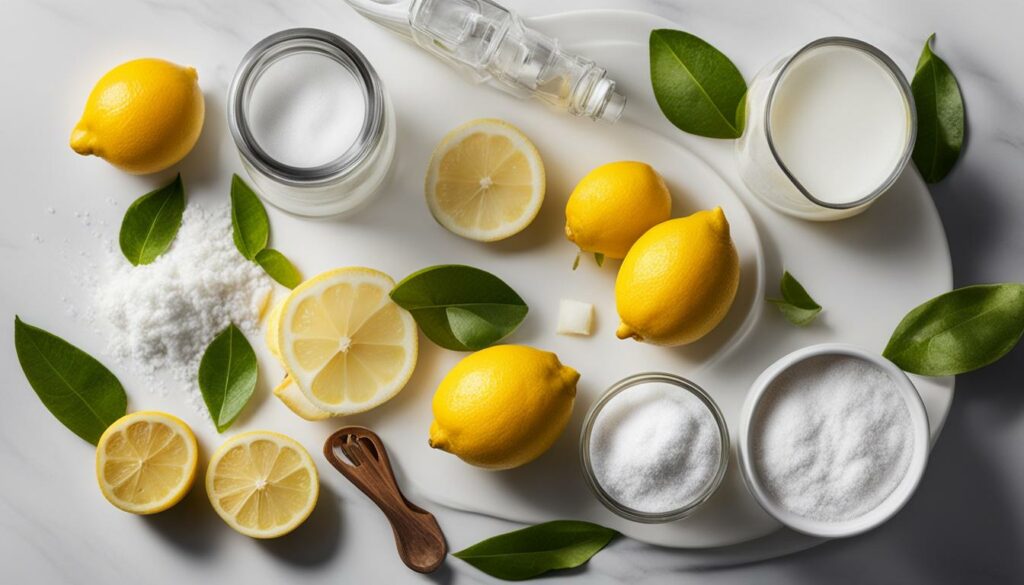
Tips for Whiter Pillowcases
Whiten your pillowcases effectively and maintain their brightness with these helpful tips:
- Pre-soak: Before washing your pillowcases, pre-soak them in a solution of lemon juice or vinegar. These natural ingredients can help remove stains and brighten the fabric. Soak the pillowcases for at least 30 minutes to allow the solution to penetrate the fibers.
- Choose the right additives: During the washing process, consider incorporating additives like baking soda, bleach, or liquid bluing to enhance the whitening effect. These can help break down stains and bring back the white appearance of your pillowcases.
- Regular washing: To maintain the whiteness of your pillowcases, wash them regularly. This helps prevent the buildup of sweat, body oils, and other substances that can cause yellowing. Follow the washing instructions on the care label for best results.
- Avoid mixing with dark or colored items: When washing your pillowcases, avoid mixing them with dark or colored items. This prevents any color bleeding that could affect the whiteness of your pillowcases. Wash white items separately to maintain their brightness.
- Air-dry in the sun: After washing, consider air-drying your pillowcases in the sun. The natural bleaching effect of sunlight can help maintain their whiteness. Hang them outside on a clothesline or lay them flat on a clean surface to dry.
Follow these tips to keep your pillowcases looking fresh, clean, and beautifully white.
“An effective regime for maintaining the brightness of your pillowcases involves pre-soaking, choosing the right additives, regular washing, avoiding color mixing, and air-drying in the sun.”
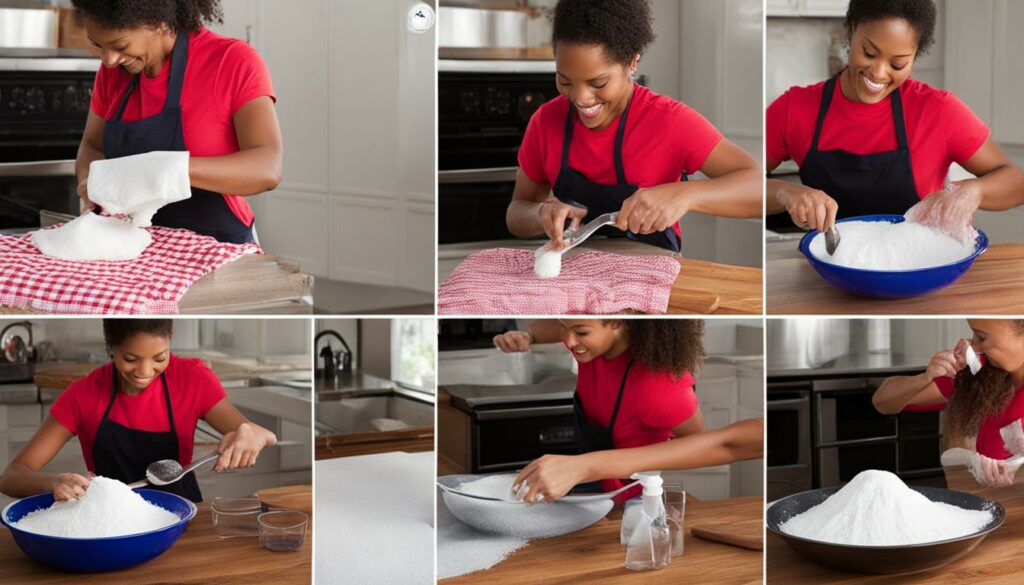
| Tips for Whiter Pillowcases |
|---|
| Pre-soak in a solution of lemon juice or vinegar |
| Choose the right additives like baking soda, bleach, or liquid bluing |
| Regularly wash your pillowcases |
| Avoid washing them with dark or colored items |
| Air-dry in the sun for a natural bleaching effect |
Removing Sweat and Yellow Stains from Sheets
Sweat stains on pillowcases can be unsightly and difficult to remove. Luckily, you can follow a few simple steps to eliminate these stains and prevent yellowing. By taking proactive measures and using effective cleaning techniques, your pillowcases can stay fresh and white for longer.
Pre-Soaking Method
One effective method to remove sweat stains and yellow discoloration from pillowcases is pre-soaking them in a solution of dishwashing detergent and baking soda. Follow these steps:
- Fill a basin or sink with warm water
- Add a tablespoon of dishwashing detergent and a tablespoon of baking soda
- Stir the solution until the detergent and baking soda dissolve
- Submerge the pillowcases in the solution and gently agitate them to ensure they are fully saturated
- Let them soak for at least 30 minutes, or overnight for more stubborn stains
- After soaking, remove the pillowcases from the solution and wring out any excess liquid
- Wash the pillowcases as usual, following the care instructions on the label
This pre-soaking method helps break down sweat stains and remove yellow discoloration, leaving your pillowcases looking bright and clean.
Regular Washing and Stain Prevention
In addition to the pre-soaking method, regular washing and preventative measures can help maintain the whiteness of your pillowcases. Here are some tips:
- Wash your pillowcases regularly, ideally once a week or every two weeks
- Use a good-quality laundry detergent specifically designed for white fabrics
- Avoid using excessive detergent as it can leave residue and contribute to yellowing
- Consider adding washing soda to your washing cycle as it enhances the whitening effect
- Avoid eating in bed to prevent food stains from transferring to your pillowcases
By following these tips, you can keep your pillowcases looking fresh and free from sweat and yellow stains.
| Tip | Description |
|---|---|
| Wash pillowcases regularly | Regular washing prevents the buildup of sweat and oils on your pillowcases. |
| Use white-specific detergent | Using a detergent formulated for white fabrics helps maintain their brightness. |
| Avoid excessive detergent usage | Using too much detergent can leave residue and contribute to yellowing. |
| Add washing soda | Enhance the whitening effect by adding washing soda to your wash cycle. |
| Avoid eating in bed | Prevent food stains from transferring to your pillowcases by avoiding eating in bed. |
Following these tips will help you maintain the whiteness of your pillowcases, ensuring a clean and refreshed look for your bedding.
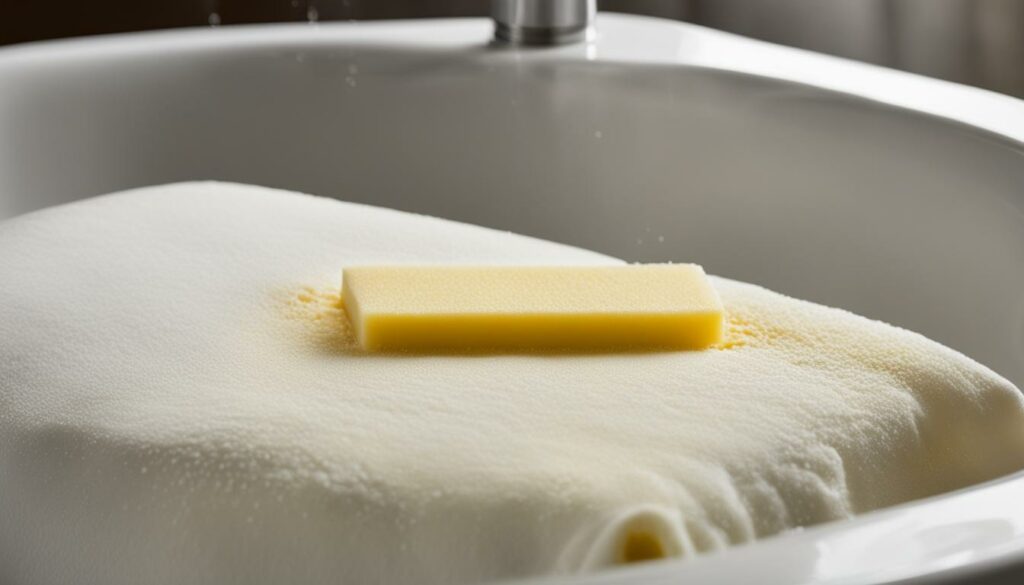
Tips for Whiter Pillowcases
To prevent yellow stains on your pillowcases, it’s important to follow proper laundry techniques and maintenance. Here are some tips to help you keep your pillowcases looking fresh and white:
- Wash Regularly: Regular washing is essential to prevent stains and yellowing. Aim to wash your pillowcases at least once a week, or as needed.
- Use Washing Soda: Adding washing soda to your washing cycle can enhance the whitening effect. Simply sprinkle a small amount of washing soda into the washing machine along with your regular detergent.
- Avoid Excessive Detergent: Using too much detergent can leave residue on your pillowcases, leading to yellowing. Follow the recommended dosage on your detergent packaging and avoid overloading the machine.
- Choose Filler-Free Detergent: Opt for filler-free washing detergent to maintain the brightness of your pillowcases. Fillers in detergent can contribute to dullness and yellowing over time.
- Replace Worn Out Pillowcases: Regularly inspect your pillowcases for signs of wear and tear. Replace any pillowcases that are discolored, thinning, or showing signs of aging.
By following these tips, you can keep your pillowcases looking fresh and white, enhancing the overall appearance of your bedding.
Expert Tip:
“Regular maintenance and attention to laundry techniques are key to maintain white pillowcases. By incorporating these tips into your routine, you can enjoy whiter and brighter bedding throughout the year.” – Sarah Johnson, Laundry Expert
| Tip | Description |
|---|---|
| Wash Regularly | Regularly washing your pillowcases prevents stains and yellowing. |
| Use Washing Soda | Adding washing soda to your washing cycle can enhance the whitening effect. |
| Avoid Excessive Detergent | Using too much detergent can leave residue on your pillowcases, leading to yellowing. |
| Choose Filler-Free Detergent | Opt for filler-free washing detergent to maintain the brightness of your pillowcases. |
| Replace Worn Out Pillowcases | Regularly inspect your pillowcases for signs of wear and tear and replace them as needed. |
By incorporating these tips into your pillowcase care routine, you can prevent yellowing and maintain the whiteness of your pillowcases for a crisp and clean look.
How to Remove Yellow Stains from Pillowcases
If your pillowcases have developed yellow stains, don’t worry! There’s a simple soaking method you can try to remove the discoloration and bring back their bright whiteness.
Follow these steps:
- Fill a tub or bath with hot water.
- Add dishwashing detergent and baking soda to the water.
- Place the yellowed pillowcases in the tub and ensure they are fully submerged.
- Let the pillowcases soak overnight, allowing the mixture to penetrate the fabric and break down the stains.
- After soaking, transfer the pillowcases to the washing machine.
- Add vinegar and your regular detergent to the wash cycle.
- Wash the pillowcases on a normal cycle.
- Once the washing cycle is complete, inspect the pillowcases for any remaining stains.
- If needed, repeat the soaking and washing process until the stains are completely gone.
- Finally, hang the pillowcases in the sun to dry. The sunlight will help further whiten the fabric and eliminate any lingering odors.
This soaking method can be highly effective in removing yellow stains and reviving the appearance of your pillowcases. Give it a try and enjoy the fresh, pristine look of your bedding!
Why Pillowcases Turn Yellow and Prevention Tips
Over time, your pillowcases can develop unsightly yellow stains. This discoloration is often caused by the accumulation of sweat and body oils on the fabric. Understanding why pillowcases turn yellow and implementing preventive measures can help you maintain the whiteness of your pillowcases for longer.
Here are some tips to prevent yellowing and maintain the freshness of your pillowcases:
- Regular Washing: Washing your pillowcases regularly is crucial to prevent the buildup of sweat and body oils. Aim to wash your pillowcases at least once every week.
- Proper Detergent Usage: Avoid using too much detergent when washing your pillowcases. Excessive detergent can leave residue on the fabric and contribute to yellowing. Ensure that the detergent you use is filler-free to maintain the brightness of your pillowcases.
- Washing Soda: Adding washing soda to your laundry can enhance the whitening effect. Wash your pillowcases as usual, but include a scoop of washing soda in the washing machine to help remove stains and keep the fabric white.
- Good Hygiene: Practicing good hygiene habits, such as showering before bed, can help reduce the amount of sweat and body oils that come into contact with your pillowcases. Clean skin is less likely to contribute to yellow stains.
By following these preventive measures, you can effectively minimize yellowing and keep your pillowcases looking fresh and clean.
Comparison of Prevention Tips
| Prevention Tips | Effectiveness | Ease of Implementation |
|---|---|---|
| Regular Washing | High | Easy |
| Proper Detergent Usage | Moderate | Easy |
| Washing Soda | High | Moderate |
| Good Hygiene | Moderate | Easy |
Implementing these prevention tips can help extend the lifespan of your pillowcases and ensure that they stay white and fresh for longer periods. Taking care of your bedding not only improves its appearance but also promotes better hygiene and a more comfortable sleeping experience.
Additional Tips for Whiter Pillowcases
In addition to the previously mentioned tips, there are a few more ways to keep your pillowcases looking white and fresh.
Avoid Eating in Bed
One of the common causes of stains on pillowcases is food spills. To prevent food stains, it is best to avoid eating in bed altogether. By enjoying your meals in designated areas, you can minimize the risk of food stains on your pillowcases.
Wash Bedding with Other White Items
If you want to prevent color bleeding and maintain the whiteness of your pillowcases, it’s a good idea to wash them with other white items. Separating your white bedding from colored or dark items during laundry can help prevent any transfer of color and preserve the bright white appearance of your pillowcases.
Clean Your Face Before Bed
Oils and cosmetics can easily transfer onto your pillowcases, causing stains and discoloration. To prevent this, make sure to establish a routine of cleaning your face before bed. Removing any dirt, oils, and makeup from your face can help keep your pillowcases looking pristine.
Regularly Replace Pillowcases
Pillowcases endure regular use and can eventually show signs of wear, tear, and discoloration. To prolong the whiteness and overall quality of your pillowcases, it is recommended to replace them every two to three years. By doing so, you can ensure that you always have fresh, bright pillowcases for a clean sleeping environment.
| Tips for Whiter Pillowcases |
|---|
| Avoid eating in bed |
| Wash bedding with other white items |
| Clean your face before bed |
| Regularly replace pillowcases |
Conclusion
By implementing the right techniques and practicing proper care, you can maintain the bright and white appearance of your pillowcases, ensuring a fresh and rejuvenating sleep experience. Whether you choose natural methods like lemon juice and vinegar or rely on household ingredients like baking soda and bleach, these tips and tricks offer effective solutions for achieving whiter pillowcases and preserving their pristine condition.
Regular washing, along with careful attention to stain removal and preventative measures, plays a vital role in prolonging the longevity and whiteness of your pillowcases. Following these professional tips will help you keep your bedding looking its best, providing you with the ultimate in comfort and cleanliness.
So, embrace these expert suggestions and enjoy the benefits of a bed adorned with fresh, bright pillowcases. Say goodbye to yellowing and hello to a renewed sleep sanctuary with these essential techniques for maintaining white pillowcases.
FAQ
How can I whiten my pillowcases naturally?
You can use natural remedies like lemon juice, vinegar, baking soda, and borax to whiten your pillowcases. Lemon juice and vinegar can be added to the washing machine or used in a soaking solution, while baking soda and borax can be effective stain removers and brighteners.
Is bleach a good option for whitening pillowcases?
While bleach can be used to whiten pillowcases, it is not recommended as the ideal solution. Bleach can react with protein stains and should not be used on silk sheets. Non-chlorine oxygen bleach can be a suitable alternative for whitening pillowcases.
What are some other whitening agents for pillowcases?
Liquid bluing and hydrogen peroxide can be effective for whitening pillowcases. Liquid bluing can neutralize yellow undertones, while hydrogen peroxide, when used with other cleaning agents, can help whiten pillowcases. It’s important to follow specific instructions for optimal results.
How can I keep my pillowcases looking whiter for longer?
To maintain the whiteness of your pillowcases, you can pre-soak them in a solution of lemon juice or vinegar, use whitening agents like baking soda or bleach during the washing process, wash them regularly, avoid washing them with dark or colored items, and air-dry them in the sun.
How can I remove sweat and yellow stains from pillowcases?
Pre-soaking your pillowcases in a solution of dishwashing detergent and baking soda can help break down sweat stains and remove yellow discoloration. Regular washing and avoiding eating in bed can also prevent the buildup of stains on your pillowcases.
What can I do to prevent yellow stains on my pillowcases?
To prevent yellow stains on your pillowcases, it’s important to wash them regularly, use washing soda to enhance the whitening effect, avoid excessive detergent usage, use filler-free washing detergent, and regularly replace pillowcases that show signs of wear and tear.
How can I remove yellow stains from pillowcases?
To remove yellow stains from your pillowcases, you can try soaking them overnight in a solution of hot water, dishwashing detergent, and baking soda. Then, transfer them to the washing machine and wash with vinegar and detergent. Drying them in the sun can provide a natural bleaching effect.
Why do pillowcases turn yellow and how can I prevent it?
Pillowcases turn yellow over time due to sweat and body oils that accumulate on the fabric. To prevent yellowing, it’s important to wash your pillowcases regularly, avoid using too much detergent, add washing soda to your washing cycle, use filler-free detergent, practice good hygiene, and regularly replace worn pillowcases.
What are some additional tips for whiter pillowcases?
Avoid eating in bed to prevent food stains, wash your bedding with other white items to prevent color bleeding, and make sure to clean your face before bed to prevent oils and cosmetics from staining your pillowcases. Regularly replacing pillowcases after two to three years of use is also recommended.
Eric Christie stands as a luminary in the bedding industry, with a career spanning nearly four decades since the early 1980s. His journey through the world of bedding has seen him wear many hats – a manufacturer, designer, and retailer, showcasing his versatility and expertise in Read more...


